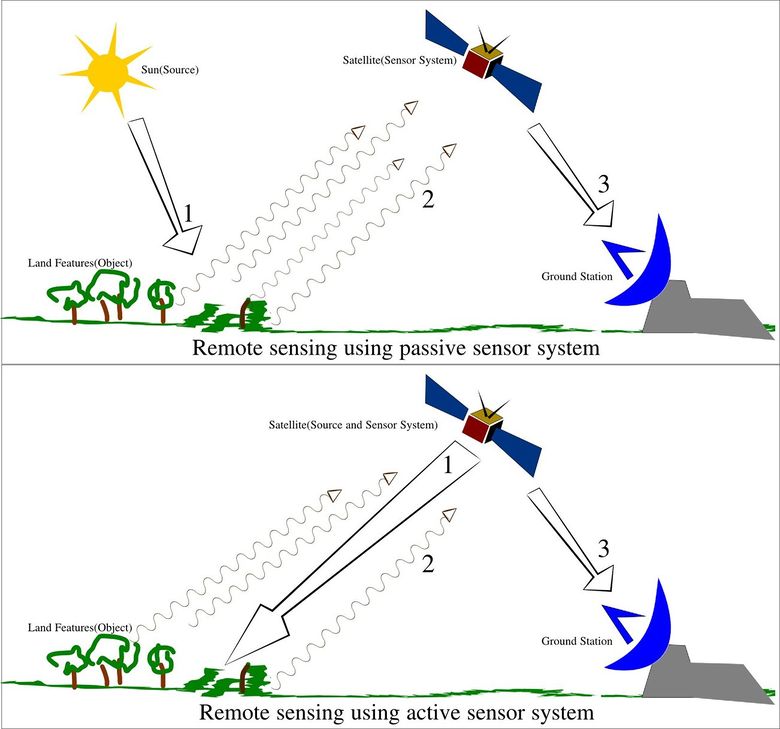Remote sensing: Difference between revisions
No edit summary |
J.williams (talk | contribs) m (1 revision imported) |
(No difference)
| |
Revision as of 01:47, 13 November 2015
Remote sensing is the science of measuring properties of an object without physical contact with that object.[1] Remote sensing has a variety of applications in many different industries because it is an information collection tool. In the energy industry, remote sensing can help find good places to put various generation stations like hydropower, solar power and wind power. This could include satellite measurements.
Active and Passive Sensors
Passive sensors are sensors that measure existing light levels.[2] A digital camera would be considered a passive sensor as would a thermal or infrared camera. Passive sensors are limited to operating in environments with measurable levels of light. If light levels are too low, the sensors aren’t able to collect any information. Active sensors send out a signal that illuminates the surface and measure the properties of the return signal.[2] An example of an active sensor would be Light Detection and Ranging (LiDAR). LiDAR sends out short laser bursts and measures the time it takes for the signal to return.[3] LiDAR is used to measure the distance of a surface from the sensor. Active sensors require more energy than passive sensors because they send out a signal to illuminate the surface.[2] However, they are not limited by existing light levels.

Platforms
Sensors are attached to various types of platforms.[5] A platform is the structure that carries the sensor itself. Platforms can be stationary or designed to move to allow the sensor to collect more data. Platforms are divided into three categories:
- Ground-based - Ground-based sensors are mounted on a platform that stays in contact with the ground.
- Airborne - Airborne sensors are generally mounted on planes or, in some cases, on balloons
- Spaceborne - Spaceborne sensors are mounted on satellites.
Applications in Energy
Remote sensing has a variety of information collection applications in the energy industry. Active sensors can be used for wind resource measurement or to create models of local elevation.[3][6] Wind measurements can be used to locate potential sites for offshore wind turbines[6] Elevation models are useful for planning hydroelectric plants or areas that have fewer obstructions for wind turbines or electricity transmission lines.[6][7][8]
Passive, spaceborne instruments provide images of the surface that are used to identify areas where crude oil or natural gas may be present.[5] They can also be used to identify areas with the least cloud cover; these areas are better-suited for solar panels.[9]
References
- ↑ Natural Resources Canada (2011). "Remote Sensing". [Online] Available: http://www.nrcan.gc.ca/earth-sciences/geography-boundary/remote-sensing/11691
- ↑ 2.0 2.1 2.2 P.R. Baumann (2010). "Introduction to Remote Sensing". [Online] Available: http://www.oneonta.edu/faculty/baumanpr/geosat2/RS-Introduction/RS-Introduction.html
- ↑ 3.0 3.1 NOAA (2013). "LiDAR - Light Detection and Ranging - is a remote sensing methods used to examine the surface of the Earth" [Online] Available: http://oceanservice.noaa.gov/facts/lidar.html
- ↑ Wikimedia Commons. (October 4, 2015). Remote Sensing [Online]. Available: https://upload.wikimedia.org/wikipedia/commons/6/61/Remote_Sensing_Illustration.jpg
- ↑ 5.0 5.1 Q.K. Hassan, "ENGO 435 Lecture Notes", Geomatics Engineering, University of Calgary, 2012. Cite error: Invalid
<ref>tag; name "Ref4" defined multiple times with different content - ↑ 6.0 6.1 6.2 I. Karagali, M. Badger, A.N. Hahmann, A. Pena, C.B. Hasager and A.M. Sempreviva, "Spatial and temporal variability of winds in the Northern European seas," Renew Energy, vol. 57, pp. 200-210, Sept. 2013
- ↑ Z. Xu, F. Yang, Y. Huang, Z. Wang, Y. Liu (2008) "LiDAR applications in the electric power industry" [Online] Available: http://www.isprs.org/proceedings/XXXVII/congress/4_pdf/26.pdf
- ↑ Merrett Survey Partnership (2009). "Hydro Electricity - Mini hydro Schemes" [Online] Available: http://www.lidar.co.uk/Hydro-Electricity.htm
- ↑ Green Power Labs (n.d.) "Resource Assessment". [Online] Available: http://www.greenpowerlabs.com/services_ra.html

